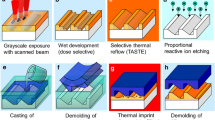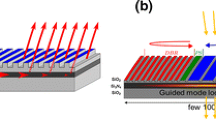Abstract
The mold fabrication is a critical issue for the development of nanoimprint lithography as an effective low-cost and mass production process. This paper describes the fabrication process developed to fabricate the large area nanoimprint molds on the silicon wafers. The optimization of e-beam exposure dose and pattern design is presented. The overlayer process is developed to improve the field stitching accuracy of e-beam exposure, and around 10 nm field stitching accuracy is obtained. By means of the optimization of the e-beam exposure dose, pattern design and overlayer process, large area nanoimprint molds having dense line structures with around 10 nm field stitching accuracy have been fabricated. The fabricated mold was used to imprint commercial imprinting resist.
Similar content being viewed by others
References
Chou S Y, Kruss P R, Renstrom P J. Imprint of sub-25 nm vias and trenches in polymers. Appl Phys Lett, 1995, 67: 3114–3116
Chou S Y, Kruss P R, Renstrom P J. Imprint lithography with 25-nanometer resolution. Science, 1996, 272: 85–87
Chou S Y, Kruss P R, Zhang W, et al. Sub-10 nm imprint lithography and applications. J Vac Sci Technol B, 1997, 67: 2897–2904
Maximov I, Carlberg P, Wallin D, et al. Nanoimprint lithography for fabrication of three-terminal ballistic junctions in InP/GaInAs. Nanotechnol, 2002, 13(5): 666–668
Ahn S W, Lee K D, Kim J S, et al. Fabrication of subwavelength aluminum wire grating using nanoimprint lithography and reactive ion etching. Microelectron Eng, 2005, 78–79: 314–318
Wu W, Cui B, Sun X Y, et al. Large area high density quantized magnetic disks fabricated using nanoimprint lithography. J Vac Sci Technol B, 1998, 16: 3825–3829
Falconnet D, Pasqui D, Park S, et al. A novel approach to produce protein nanopatterns by combining nanoimprint lithography and molecular self-assembly. Nano Lett, 2004, 4: 1909–1914
Hoff J D, Cheng L J, Meyhofer E, et al. Nanoscale protein patterning by imprint lithography. Nano Lett, 2004, 4: 853–857
Park S, Schift H, Solak H H, et al. Stamps for nanoimprint lithography by extreme ultraviolet interference lithography. J Vac Sci Technol B, 2004, 22: 3246–3250
Wang X D, Chen Y F, Wang L, et al. Fabrication of nanoimprint template in Si with high etch rate by non-switch DRIE process. Microelectron Eng, 2008, 85: 1015–1017
Luo G., Xie G Y, Zhang Y Y, et al. Scanning probe lithography for nanoimprinting mould fabrication. Nanotechnol, 2006, 17: 3018–3022
Beck M, Graczyk M, Maximov I, et al. Improving stamps for 10 nm level wafer scale nanoimprint lithography. Microelectron Eng, 2002, 61–62: 441–448
Author information
Authors and Affiliations
Corresponding author
Additional information
This work was supported by the National Basic Research Program of China (Grant No. 2006CB00407), the National Natural Science Foundation of China (Grant No. 50775017) and the Program for New Century Excellent Talents in University (Grant No. NCET-04-0266).
Rights and permissions
About this article
Cite this article
Chu, J., Meng, F., Han, Z. et al. Large area mold fabrication for the nanoimprint lithography using electron beam lithography. Sci. China Ser. E-Technol. Sci. 53, 248–252 (2010). https://doi.org/10.1007/s11431-009-0320-0
Received:
Accepted:
Published:
Issue Date:
DOI: https://doi.org/10.1007/s11431-009-0320-0




